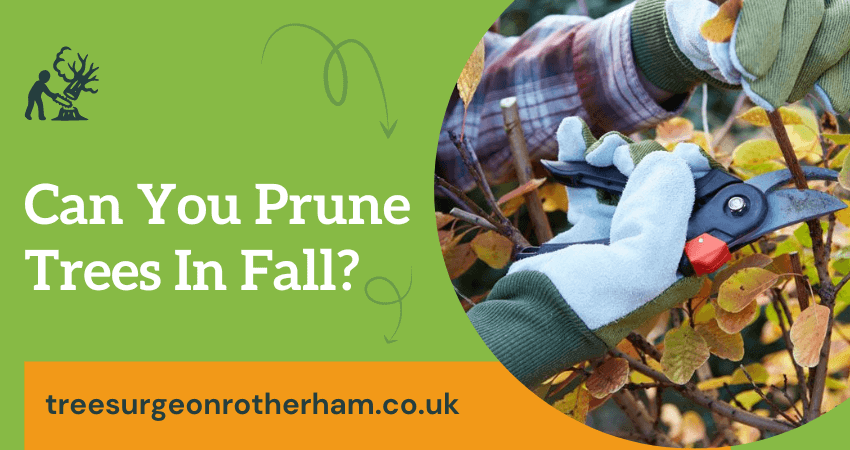Pruning trees is important for tree care and maintenance, as it helps promote healthy growth and reduces potential hazards. The question of whether or not trees can be pruned in the fall is a common one, as the timing of pruning can impact the health and appearance of a tree.
In this article, we will discuss the timing of fall pruning and how to do it effectively. We’ll also explore the pros and cons of pruning trees in the fall and provide guidelines for those who are considering this approach.
Can You Prune Trees In The Fall?
Yes, you can prune trees in the fall. It is important to note that pruning should not be done during the dormant season (from late fall to early spring). During this time, trees are preparing for winter and pruning could potentially disrupt their natural healing process.
Pruning during the growth period (late spring to early fall) is the best time to prune trees, as this is when the tree is actively growing and can quickly heal any wounds caused by pruning. Additionally, certain types of trees require specific timing for pruning to protect their health and growth.
It is always recommended that you consult a qualified arborist or tree expert before making any decisions about when to prune your trees.
Pros of Pruning Trees in Fall
- Pruning trees in the fall helps to encourage healthy growth and reduce disease risk.
- It can help prevent damage from strong winds or heavy snowfall during winter months, as well as reduce the effects of drought.
- Pruning also helps to improve air circulation and light penetration throughout the tree’s canopy, which promotes healthier foliage and increased flowering.
- Pruning in the fall can help reduce pest damage as well, by removing branches with weakened tissue or damaged bark that may attract insects and disease.
- Finally, pruning during autumn helps to shape trees for a balanced aesthetic appeal throughout the year. Properly pruned trees add value and beauty to any landscape, making them an important part of landscape maintenance.
Cons of Pruning Trees in Fall
- Pruning during the fall season may cause additional stress to trees, as they are already preparing for dormancy and low temperatures.
- If pruned too late in the season, some tree species may have difficulty healing before winter sets in, which can leave them vulnerable to disease and other damage.
- Pruning during the fall can also disrupt bird migration and the natural patterns of wildlife, which depend on trees for food and shelter.
- Finally, pruning in the fall can encourage new growth that may not be hardy enough to survive winter conditions, leading to weakened or dead branches in spring.
- For these reasons, it is essential to consult a professional arborist or tree care specialist before pruning trees in the fall. They can help determine the best time of year to prune and provide advice on proper techniques.
Factors to consider when pruning trees in the fall
- Species of the Tree: It is important to consider the type of tree you are looking to prune when deciding how much or how little pruning to do. Some trees are more sensitive to pruning than others, so it is important to research the species before beginning any work.
- Age of the Tree: The age of the tree is also essential when it comes to pruning. Older trees may not be able to handle as much pruning as younger trees can, so it’s important to take this into account.
- The health of the tree: When pruning, it’s important to take into account the overall health of the tree. If a tree is struggling with disease or damage, it should be handled with extra caution and care during pruning.
- Pruning tools: It is important to use the right tools when pruning a tree. Sharp, clean implements should be used to prevent damage to the tree and its branches.
- Time of Year: Pruning at different times of the year can have different effects on a tree’s growth. Generally, late fall and winter months are the best time to prune since there is minimal sap flow.
- Weather Conditions: When pruning a tree, it’s important to factor in the weather conditions. Pruning a tree during a windy or rainy day can cause more damage than good, so it’s important to consider this.
- Location of the Tree: Finally, it is important to consider the location of the tree when pruning. Trees that are located in an area with high levels of pollution or near a construction site may require more frequent pruning due to increased stress on the tree.
Additionally, trees growing near power lines may need regular maintenance and trimming to reduce any risk of contact.
Overall, there are many factors to consider when pruning trees in the fall. Taking all these factors into account will help ensure a safe and successful job.
Techniques for Pruning Trees in the Fall
1) Crown Reduction
This technique is used to reduce the overall size of a tree, usually by removing entire branches near the top. The goal is to reduce excessive weight and wind resistance while maintaining good health and aesthetics.
2) Crown Thinning
This technique involves selectively removing smaller secondary branches, often leaving behind larger, more structurally sound branches. This can help reduce the density of a tree while still providing adequate foliage coverage.
3) Crown Cleaning
This technique involves removing dead, dying or damaged branches to reduce clutter and improve the aesthetic appeal of a tree. It also helps increase light penetration by eliminating obstructions.
4) Crown Raising
This technique involves selectively removing lower branches to provide more clearance. This can improve the aesthetics of a tree by giving it a cleaner look and making it easier for pedestrians to walk beneath it.
It can also reduce the risk of damage from passing vehicles or animals. The goal is to maintain the canopy shape and overall integrity of the tree while still providing adequate access underneath. This technique should be done carefully to avoid damaging the tree.
Overall, these are all important techniques for pruning trees in the fall. By using a combination of these methods and taking care not to over-prune, arborists can help ensure that trees remain healthy and aesthetically pleasing for years to come.
Wrap Up
Many people think that tree pruning should only be done in the spring, but fall is a great time to do it. Trees are dormant in the fall, so they can better withstand pruning. Fall pruning also allows you to shape trees before they begin growing again in the spring.
As you can see, there are a few things to consider before pruning your trees in the fall. If done correctly, however, fall tree pruning can be beneficial for the health of your trees. Use these tips to ensure that you are pruning your trees properly this fall season.
So if you have some trees that need to be trimmed, don’t wait until spring gets started in the fall!




